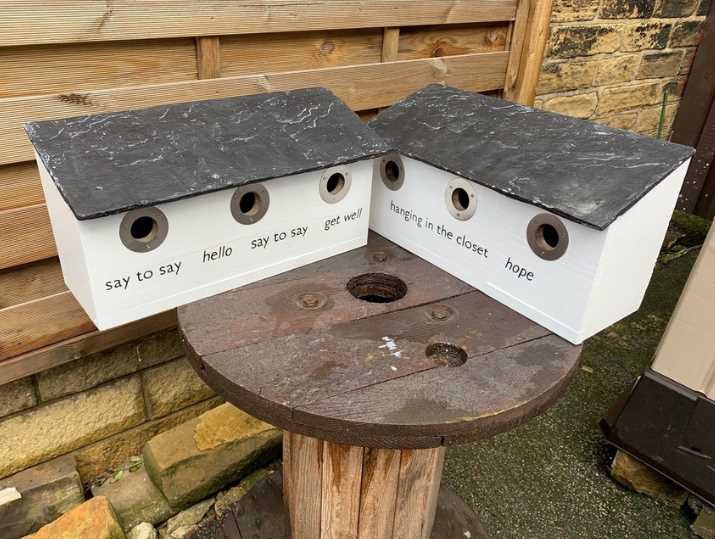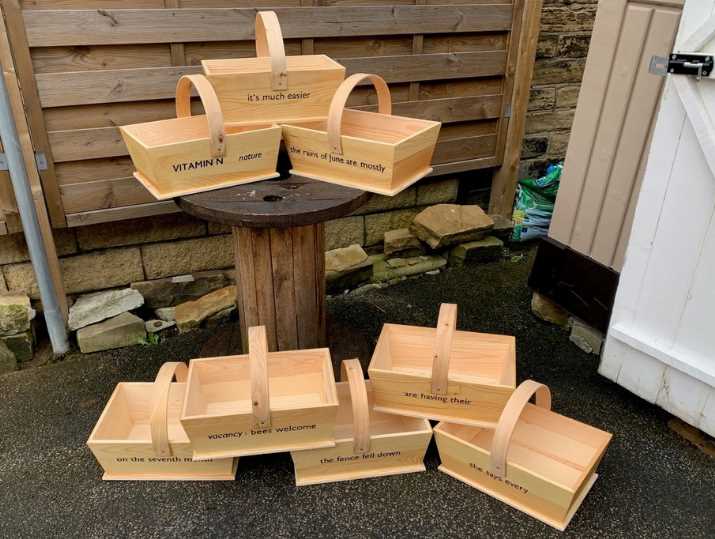Alec is working with our Dementia Friendly Walking team on an exciting project to transform two shared garden spaces at Murray Royal Hospital in Perth, which is due for completion later this year. Alec shares with us insight into his creative process on how we connect patients, staff and families to nature, and encourage physical activity.
Some of you will know that, as artist-in-residence for Paths for All, I’ve been creating poem walking sticks for a few Health Walk groups. The poems are proverbs about what it means to share a walk, or memorials for friends lost during the pandemic.
For twenty years I’ve worked with a traditional sign-writer, Chris Ellis, who lives in Yorkshire, and works across the UK. Together, as well as walking sticks, we’ve made benches and nest-boxes with poems – some of the boxes were installed in care homes in Perthshire, to encourage residents to spend time in their grounds and gardens.
In the art world there’s a tradition of adding texts or poems to everyday things, and such works are commonly known as ‘poem-objects’. Growing up with a poet father, in a rather cobwebby shepherd’s cottage, I became used to poems appearing on signposts in the garden – ‘ready next year’ and ‘work in progress’ were handy ways to explain an area of nettles or recently dug earth – and, in later years, poems appeared on wardrobes, and even in the bath. There’s something rather lovely about seeding poetry in everyday life and, as my friend Thomas says, sharing a domestic art of ‘dailyness’.

One distinction of these poems is that they must be short – never a bad thing – akin to mottos, proverbs, haiku, one-line, or one-word poems. Most chosen objects lack space for the personal and confessional poetry that’s become so familiar and, instead of being ‘I’ poems, these tend to be ‘we’ poems, offering wry observations of things and their uses, wee encouragements, or witty observations.
For instance, the nest-boxes I made for care homes bear ‘embedded poems’, a form I adopted from the crossword, where a word or name is hidden inside a short phrase. In this case, the names of the trees upon which the boxes are installed were secreted within the poem, or, to be more accurate, the poem was composed around the trees’ given names.
For instance, can you find a familiar winter bird hopping about in this poem: ‘heart-throb in winter’. The verse suggests our sentimental fondness for these birds. This kind of poem is fun to write, and anyone can try their hand.
When I was invited to join a Paths for All team renewing green spaces by long-term care wards at a hospital in Perth, I was aware that there would be practical limits to the extent we could make these areas into traditional gardens; staff time is limited, and access issues bring their own limitations. As the spaces are used by patients, who are also encouraged to care for them as a way to occupy themselves and recuperate, I chose to create a broad range of ‘poem-objects’, including typical garden tools which could be safely used.

Gardeny things – trugs, planters, nest-boxes, seed trays, watering cans, a wheelbarrow, rakes – have a functional beauty.
poem for a garden hoe
no garden without a gardener
The designs of some tools are familiar. For others, I chose beautiful Japanese tools, which speak to a different ecology and gardening tradition, while still being influenced by the gardener’s daily tasks.
The forms of tools are practical, shaped by tradition, and I hoped they would stimulate memories, reminding patients of days in their own gardens. I also made sure to write some poems about experiences of infirmity and illness.
living with – recuperation
waiting for – recovery
the convalescents are breakfasting
in the convalescence garden
As the hospital is in Perthshire, I will make an artwork using traditional watering cans fixed on a wood trellis, each with a motto about gardening that was inspired by the writings of the Perthshire poet and gardener, G.F. Dutton (1924-2010), who was also well known as a keen mountaineer, and Professor of Biomedicine at the University of Dundee. Although rather neglected now, Dutton wrote inspiringly on marginal gardening – encouraging people to create gardens in wild landscapes and Highland ecologies. The artwork is partly a memorial to his ideas and some texts adapt his words, allowing the reader to reflect on how the concepts and practices of gardening and healing might overlap.
encourage flowers, comfort them
in a crisis, but never drive your flora
gardeners are shepherds of plants
no matter how bare, marginal, or mossy you become
you begin, and end, on and of the ground
This blog describes my approach to the project, prior to installation. It will be accompanied by future blogs that discuss what is generally involved in making a public artwork, and an update on the work at Murray Royal Hospital after the team have finished work on the garden, with photographs of the poem-objects in situ.
Learn more about the project and renovation works planned for Murray Royal Hospital in Perth here.


